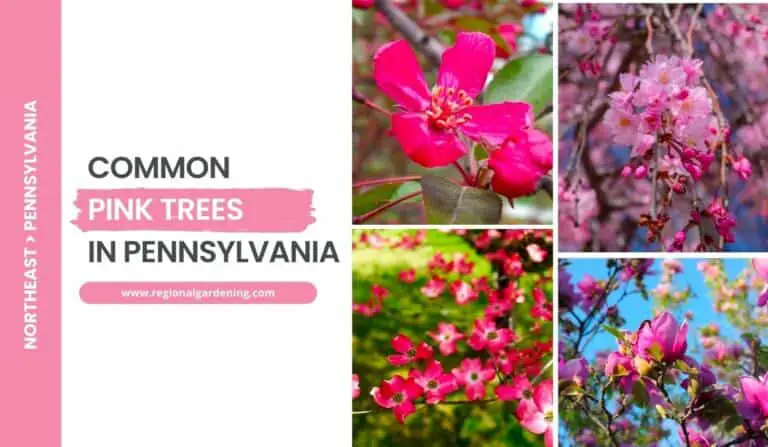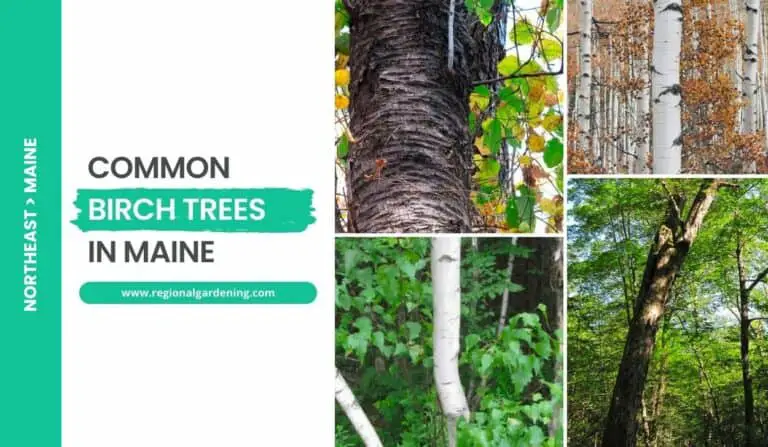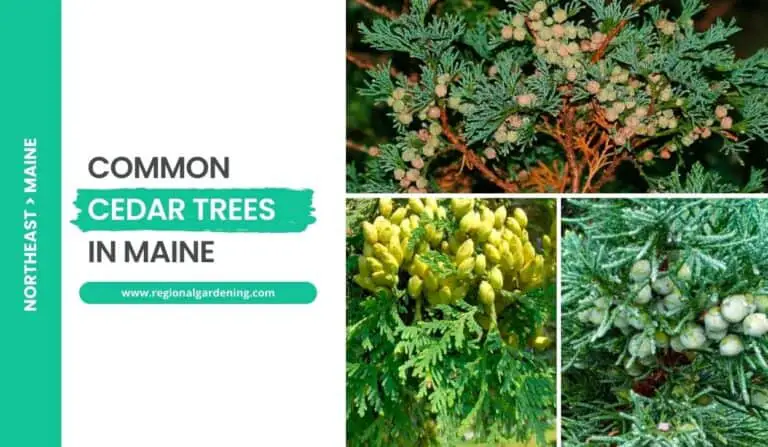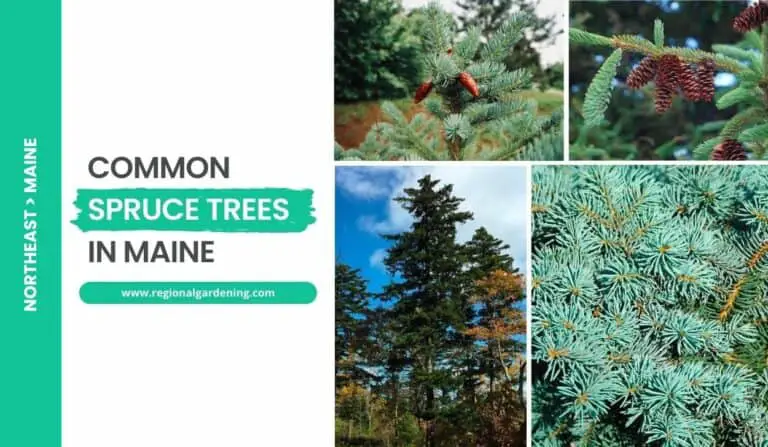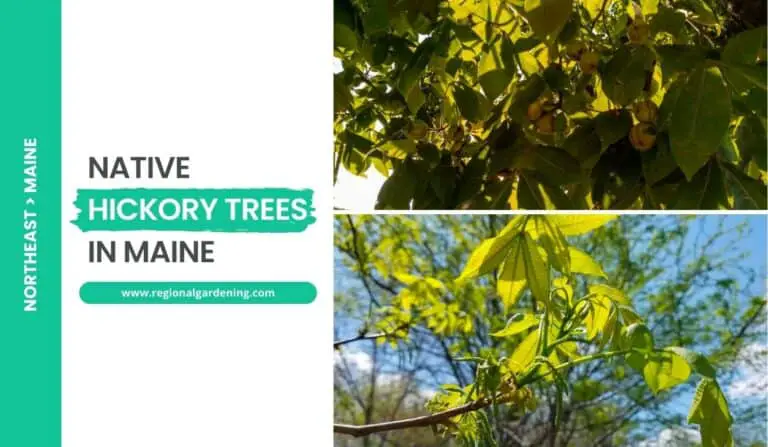6 Native Oak Trees In Pennsylvania (Photos & ID Guide)
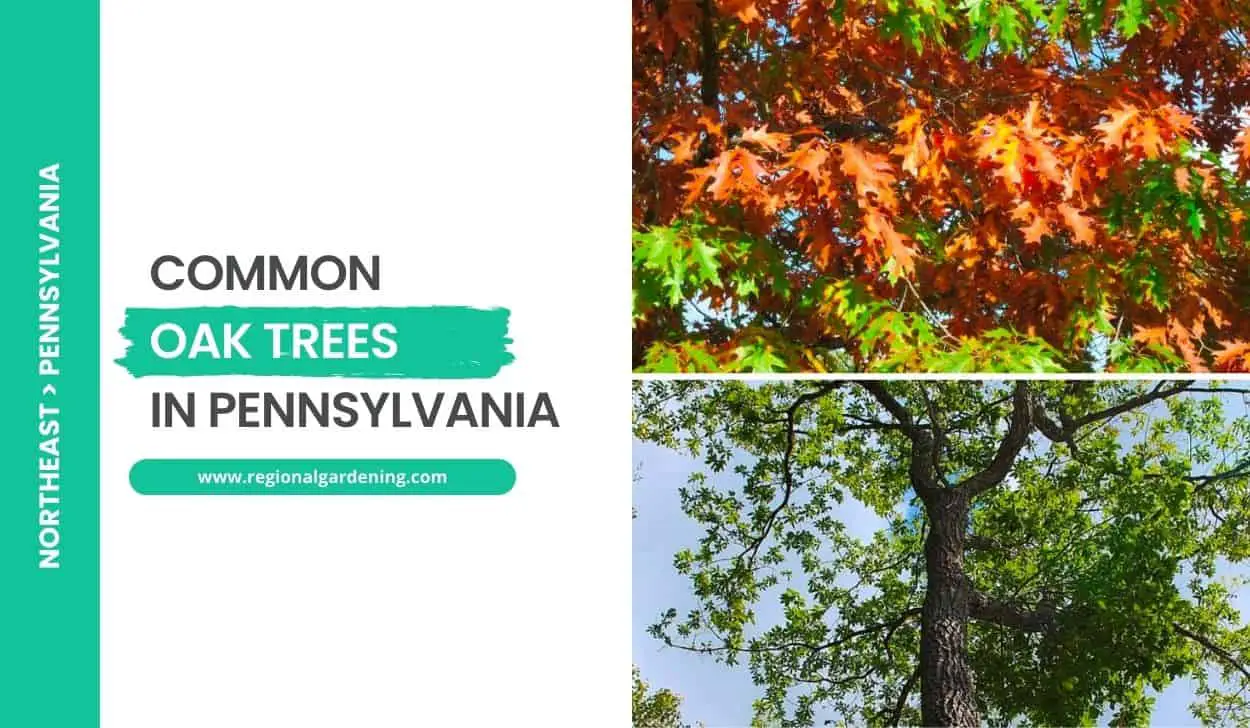
Pennsylvania has a wide variety of oak trees, each with its own unique beauty and characteristics. In this article, we will look at six of the most common oak tree species in the state, with stunning high-quality photos and detailed descriptions.
From the majestic white oak to the tough black oak, we will look at their distinct growth habits, leaf shape, and bark patterns.
So, let’s begin exploring the world of oak trees in Pennsylvania.
1. Black Oak
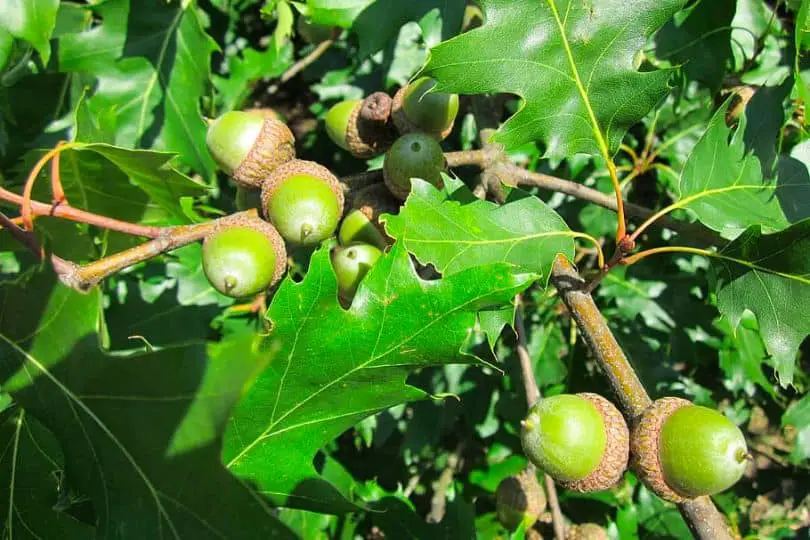
- Scientific Name: Quercus velutina Lam.
- Common Name(s): Black Oak
- Mature Height: Up to 100 feet (30 meters)
- Native Region: North America
- Leaves: Alternate, simple, 4″-8″ long, 3″-5″ wide, with 5-7 pointed lobes and a rust-brown fuzz below.
- Fruit: Acorns, ½”-1″ long, somewhat round, light brown, with a bowl-like cup that is covered in wooly hairs.
- Uses: Acorns are eaten by wildlife, young stems and twigs are browsed by deer, the bark can be used to make yellow dye, and the wood is used for general construction lumber and furniture.
Black Oak is one of the most commonly found oak trees in Pennsylvania. Its leaves are alternating, simple, and measure 4 to 8 inches long and 3 to 5 inches wide.
Each leaf has 5 to 7 pointed lobes, with sinuses between them reaching halfway to the midrib on lower leaves and deeper on top leaves. The tops of the leaves are smooth and lustrous, while the undersides are frequently covered in rust-brown fluff.
Its twigs are reddish-brown and fuzzy, while the buds are blunt-pointed, angular, yellow-grey, and woolly. As its fruit, the Black Oak produces acorns that are around 12 to 1 inch long and rather spherical in appearance. The acorn cup is bowl-shaped and hairy, with sharp-pointed cup scales forming a loose fringe at the rim. It’s worth noting that Black Oak acorns take two growing seasons to maturity, and the kernels are yellow and exceedingly bitter.
In terms of habitat, the Black Oak prefers dry, highland areas. While wildlife consumes acorns, they are not preferred by animals. Deer, on the other hand, feed on the tree’s young stems and twigs. The bark of the Black Oak can be used to manufacture a yellow dye, and the wood is frequently sold as “red oak” for basic building lumber and furniture.
Those who want to add Black Oak to their Pennsylvania landscapes should plant the tree in well-drained soil and in a spot that receives full light. Adequate spacing should be allowed for this tree to reach its full height potential.
Regular pest and disease monitoring is advised, and trimming should be done during the dormant season if necessary. Furthermore, care should be taken to avoid deer browsing damage.
2. Chesnut Oak
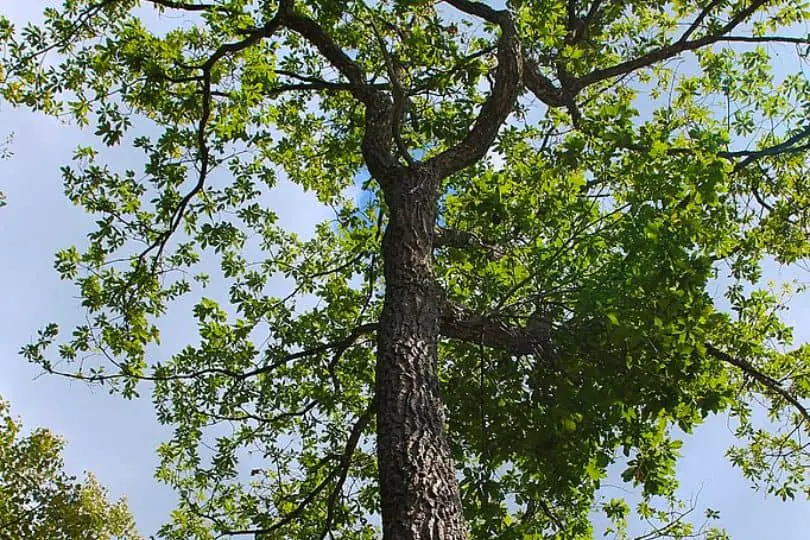
- Scientific Name: Quercus montana Willd.
- Common Name(s): Chestnut Oak, Rock Oak, Basket oak
- Mature Height: Up to 80 feet (24 meters)
- Native Region: Throughout Pennsylvania
- Fruit: An acorn, 1″ to 1½” long; rich dark brown, shiny.
- Uses: The Chestnut Oak is valued for its wood, which is heavy and strong. It is used for furniture, flooring, millwork, and railroad ties. The large crops of acorns produced by this tree every 4-7 years serve as an important food source for deer, bear, turkey, and many other birds and animals.
The Chestnut Oak, also known as the Rock oak or Basket oak, is a large tree that can grow to be 80 feet (24 meters) tall. It is widely found in Pennsylvania on dry slopes and ridgetops. The leaves are 5 to 9 inches long, alternating, simple, and have 7 to 16 pairs of coarse, rounded teeth. The upper surface is dark green and smooth, while the below surface is pale green and occasionally downy.
The smooth twigs of the Chestnut Oak range in color from orange-brown to reddish-brown. The buds are orange-brown, sharply pointed, and have hairy edges. They range in length from 14 to 12 inches.
The tree yields acorns that range in length from 1 to 112 inches. The acorns are dark brown and glossy, with a thin, hairy cup enclosing 12 to 34% of the nut. The acorn’s cup scales are knobby. The fruit matures in a single growing season and features somewhat delicious kernels.
Aside from its outward qualities, the Chestnut Oak is well-known for its applications. The bark of the tree is high in tannin, making it useful for tanning leather. The Chestnut Oak’s wood is heavy and sturdy, making it suitable for a variety of tasks. It’s often used to make furniture, flooring, millwork, and railroad ties.
In terms of ecological importance, the Chestnut Oak generates massive acorn crops every 4 to 7 years. These acorns provide a significant source of food for a variety of wildlife, including deer, bear, turkey, and a variety of other birds and mammals. The presence of trees in Pennsylvania landscapes not only adds beauty but also provides habitat for local wildlife populations.
When caring for chestnut oak trees in Pennsylvania, it is necessary to provide well-drained soil since the tree loves dry slopes and ridgetops. Watering the tree regularly, especially during dry months, will aid in the establishment of its root system.
Pruning can also be done to keep the tree’s shape and remove any dead or broken limbs. By giving the proper care, Chestnut Oaks may thrive in Pennsylvania landscapes and add to the region’s overall beauty and biodiversity.
3. Northern Red Oak
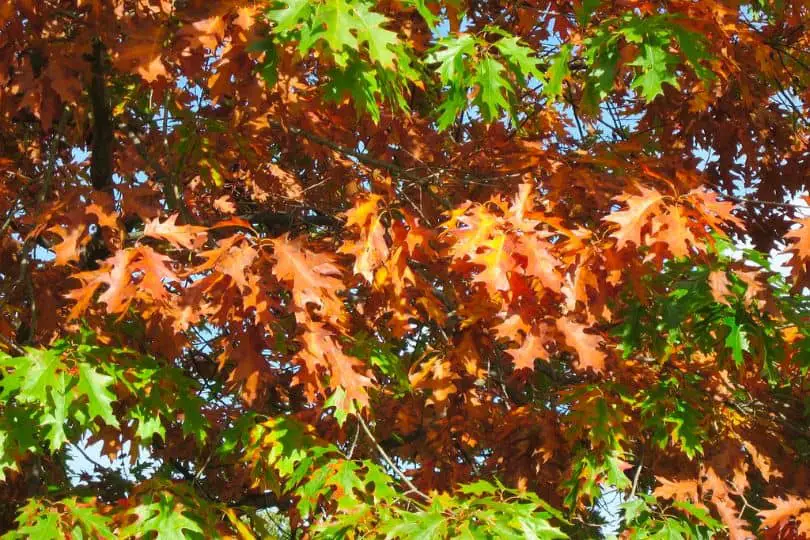
- Scientific Name: Quercus rubra L.
- Common Name(s): Northern Red Oak
- Mature Height: Can grow to 100 feet or more (30 meters or more)
- Native Region: Native to North America, including Pennsylvania.
- Fruit: Produce acorns that are ¾” to 1¼” long.
- Bark: Smooth and greenish-brown or gray when young, maturing to dark gray or nearly black.
Northern Red Oak, or Quercus rubra, is a common and dominating forest tree in Pennsylvania. It grows to be over 100 feet tall when mature, making it a towering and majestic tree. Northern Red Oak leaves are alternating and simple, with 7-11 bristle-tipped lobes. The upper surface of the leaves is smooth and dull green, with little tufts of reddish-brown hair in the vein axils.
Northern Red Oak twigs are greenish-brown to reddish-brown and become smooth as they age. The pointy, light brown buds have a star-shaped pith. The tree produces acorns that mature over two growing seasons. The acorns range in length from 34 to 114 inches, with a shallow, saucer-shaped cup covering a fourth of the nut. The cup scales are reddish-brown in color, narrow and tight, and occasionally fuzzy on the edges. The acorn’s kernel is bitter.
When young, the bark of the Northern Red Oak is smooth and greenish-brown or gray, but as it ages, it becomes dark gray or practically black. There are rounded ridges and smooth gray lines separating the bark.
Northern Red Oak is a popular species for planting as a shade tree in Pennsylvania. It is also highly prized for its hard and robust wood, which is used for a variety of applications including furniture, flooring, millwork, railroad ties, and veneer. Northern Red Oak acorns are an essential food source for many mammals and birds, including deer and bears.
When caring for Northern Red Oak trees in Pennsylvania, it is critical to remember that they like damp to dry soils. Watering regularly during dry months might assist in ensuring their health and energy. Furthermore, regular trimming and management techniques should be followed to keep the tree in excellent form and avoid potential risks.
4. Pin Oak
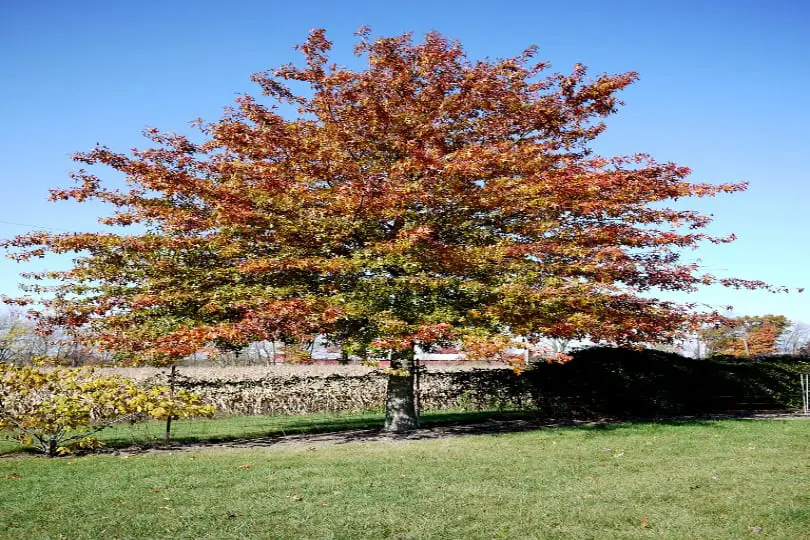
- Scientific Name: Quercus palustris Muenchh.
- Common Name(s): Pin Oak
- Mature Height: 60 to 80 feet (18 to 24 meters)
- Native Region: Southeastern, south-central, and western Pennsylvania
- Fruit: Small acorn, round about ½ inch in diameter. It is light brown, often striped with dark lines.
- Bark: Light gray-brown, smooth for many years. Old trunks have shallow fissures and narrow flat ridges.
Pin oak is a wetland tree native to southeastern, south-central, and western Pennsylvania. It can grow to be a towering and imposing tree in the landscape, reaching heights of 60 to 80 feet.
The leaves are simple and alternating, with 5-7 short lobes with bristle-tipped tips. The sinuses between the lobes are deep and rounded at the base, reaching over halfway to the mid-rib. The leaf surfaces are smooth and lustrous on top and pale on the bottom, with tufts of hairs in the vein axils.
Pin Oak twigs are dark brown-red, thin, and often have thorn-like side shoots, which give to the plant’s common name. Lower branches develop at a downward slant, while middle branches grow horizontally and upper branches grow ascending.
The tree produces small, spherical acorns about half an inch in diameter. The acorns are light brown and frequently striped with dark lines. The acorn cup is slender and saucer-shaped, containing around half of the nut. The cup scales are narrow and have a black border. The acorns ripen throughout the two seasons.
Pin Oak is commonly planted as a street tree in Pennsylvania settings due to its elegant form and ability to endure poor urban soils. Pin Oak provides significant wildlife food in addition to its aesthetic value. Acorns provide food for wetlands birds and mammals. However, the wood of Pin Oak is less valuable than that of other oak species because it warps and splits after drying.
Because Pin Oak is often found in rainy areas, it is critical to keep the soil moist and well-drained in Pennsylvania landscapes.
Watering the tree regularly during dry months might be advantageous to its growth and overall health. Prune during the dormant season to keep the tree’s shape and remove any dead or broken branches. Mulching the tree’s base can assist in preserving moisture and inhibit weed growth.
5. Scarlet Oak
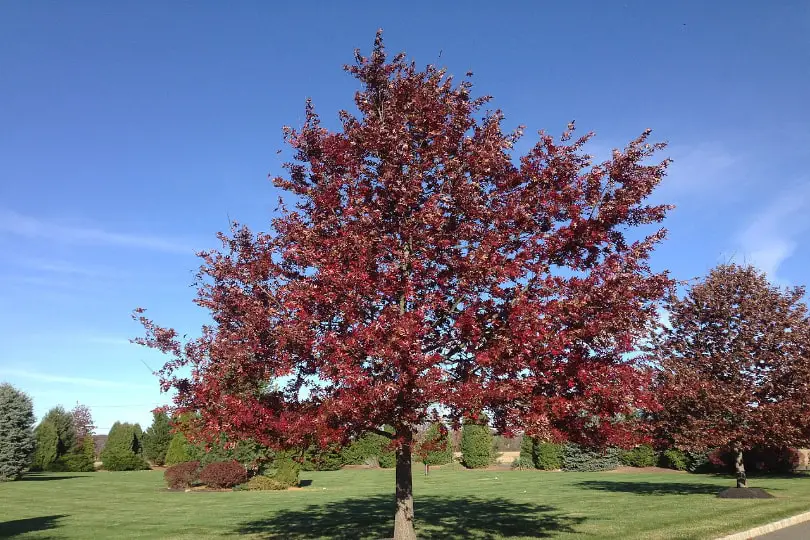
- Scientific Name: Quercus coccinea Muenchh.
- Common Name(s): Scarlet Oak
- Mature Height: Up to 80 feet (24 meters)
- Native Region: Eastern and Central North America
- Flowers: Inconspicuous flowers in the form of catkins
- Fruit: Oval-shaped acorns, approximately 1″ (2.5 cm) long, light brown with a cup-shaped covering
- Uses: The Scarlet Oak is commonly used for landscaping due to its attractive scarlet autumn color. Acorns provide food for various wildlife species.
The Scarlet Oak, formally known as Quercus coccinea Muenchh., is a medium to large-sized tree that can grow to be 80 feet tall. In its native region of eastern and central North America, it is typically found in dry highland areas, as well as many parks and streets.
Scarlet Oak leaves are alternating, and simple, and range in length from 3 to 6 inches. They have 7 to 9 thin, bristle-tipped lobes with sinuses that almost reach the mid-rib. Except for little tufts of hair in the vein-axils, the upper surface of the leaves is a lustrous bright green, while the lower surface is paler and smooth. The tree takes its name from the bright scarlet color of its autumn foliage.
When grown, the Scarlet Oak’s twigs are reddish-brown and smooth. The upper part of the buds are blunt-pointed and woolly. The tree produces inconspicuous blooms called catkins. Its fruit is made up of oval-shaped acorns that are around 1″ long. The acorns are light brown, with a cup-shaped covering that covers approximately half of the nut. The cup scales are sharply pointed, polished, and securely fastened.
The Scarlet Oak is frequently employed in Pennsylvania landscaping for its visual appeal. Its vivid scarlet autumn leaf brightens up parks, roadways, and residential areas. The tree is also prized for its acorns, which feed numerous mammals and larger birds.
It is critical to plant Scarlet Oak trees in well-drained soil while caring for them in Pennsylvania. They prefer direct sunlight but will tolerate moderate shade. Watering is required regularly, especially during dry spells. Pruning can be used to keep a healthy and appealing shape. It’s also a good idea to keep an eye out for symptoms of fungus infection, as Scarlet Oaks are prone to wood rot once they reach a certain size.
6. White Oak
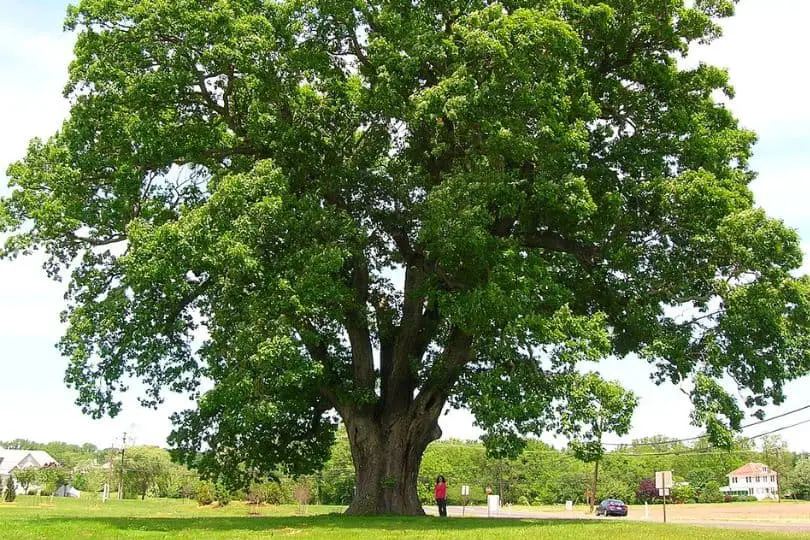
- Scientific Name: Quercus alba L.
- Common Name(s): White Oak
- Mature Height: 80′-100′ (~24-30 meters)
- Native Region: North America
- Flowers: Not specified
- Fruit: Acorn, ¾”-1″ (2-2.5 cm) long, light brown, enclosed in a cup-shaped bowl
- Uses: White oak wood is traditionally used for hardwood flooring, whiskey barrels, and boat building, and was even used to construct the famous Revolutionary War frigate, USS Constitution. Acorns are an important food source for wildlife, and Native Americans used to make flour from them.
The White Oak, scientifically known as Quercus alba L., is a common forest tree in Pennsylvania. It normally stands 80 to 100 feet (24 to 30 meters) tall. White Oak leaves are alternating and simple, measuring 6 to 9 inches (15 to 23 cm) in length and 4 inches (10 cm) in breadth. The leaves have 6 to 10 rounded lobes and are bright green on top and lighter on the bottom. The White Oak leaves turn a beautiful purple-red color in the fall.
White Oak twigs are red-grey and typically have a grayish covering. The buds are spherical and reddish-brown, with a length of up to 1/4 inch (0.6 cm). End buds are grouped. The White Oak produces light brown acorns that are 3/4 to 1 inch (2 to 2.5 cm) long as its fruit. The acorns are contained in a cup-shaped structure with hairy insides and warty cup scales. After one season, the acorns ripen in September.
The White Oak can be found in a variety of habitats throughout Pennsylvania, ranging from dry to damp environments. This tree is endemic to North America and is widely distributed throughout the continent. It is a very old tree, with some individuals living for 400 years or more.
The White Oak has numerous historical and present applications. Hardwood flooring, whiskey barrels, and boat building are among traditional applications for its timber. It is well-known for its toughness and durability.
The famed Revolutionary War frigate USS Constitution, often known as “Old Ironsides,” was built with White oak timber. Furthermore, the White Oak acorns are a significant food source for wildlife. Eastern Native Americans used to produce flour from acorns in the past, emphasizing their cultural value as well as practical application.
Similar Articles
- Common Flowering Trees In Pennsylvania
- Common Maple Trees In Pennsylvania
- Common Cherry Trees In Pennsylvania
- Common Pine Trees In Pennsylvania
- Native Locust Trees In Pennsylvania
- Common Nut Trees In Pennsylvania
- Common Cedar Trees In Pennsylvania
- Common Palm Trees In Pennsylvania
- Common Birch Trees In Pennsylvania
- Common Aspen Trees In Pennsylvania
- Common Spruce Trees In Pennsylvania
- Common Ash Trees In Pennsylvania
- Common Elm Trees In Pennsylvania
- Pink Flowering Trees In Pennsylvania
- White Flowering Trees In Pennsylvania
- Purple Flowering Trees In Pennsylvania
Native Oak Trees In Pennsylvania – Sources
The Regional Gardening team makes sure that the information in our articles is accurate by only using sources that are known to be trustworthy. Some of these sources are peer-reviewed journals from government agencies, well-known universities, and scientific research organizations.
- Native Plant Resources, Pennsylvania Native Plant Society
- Trees & Shrubs Varieties, PennState Extension
- Landscaping With Natives, Pennsylvania Department Of Conservation, & Natural Resources.
- Explore Pennsylvania Forests, Pennsylvania Department Of Conservation, & Natural Resources.


